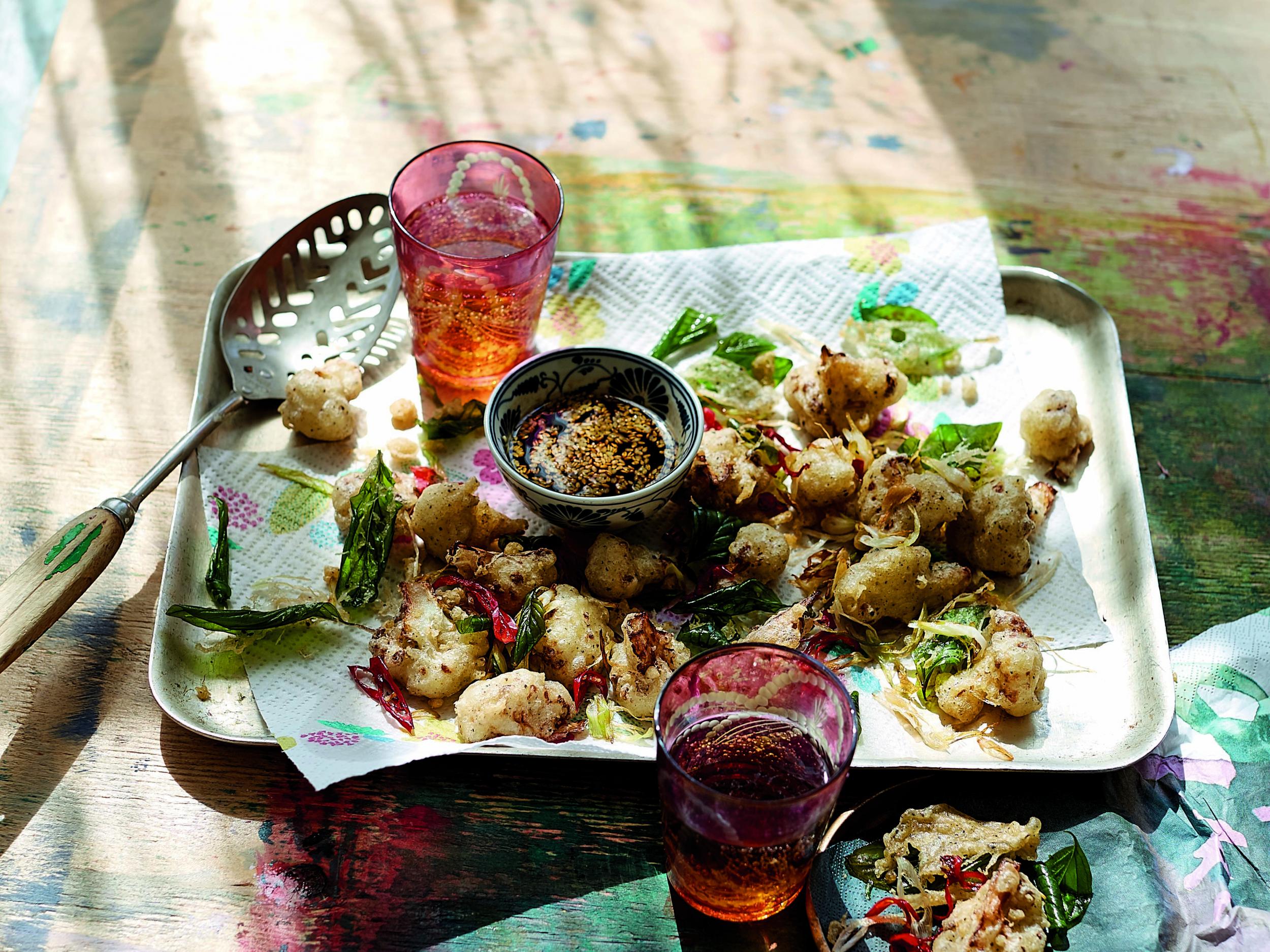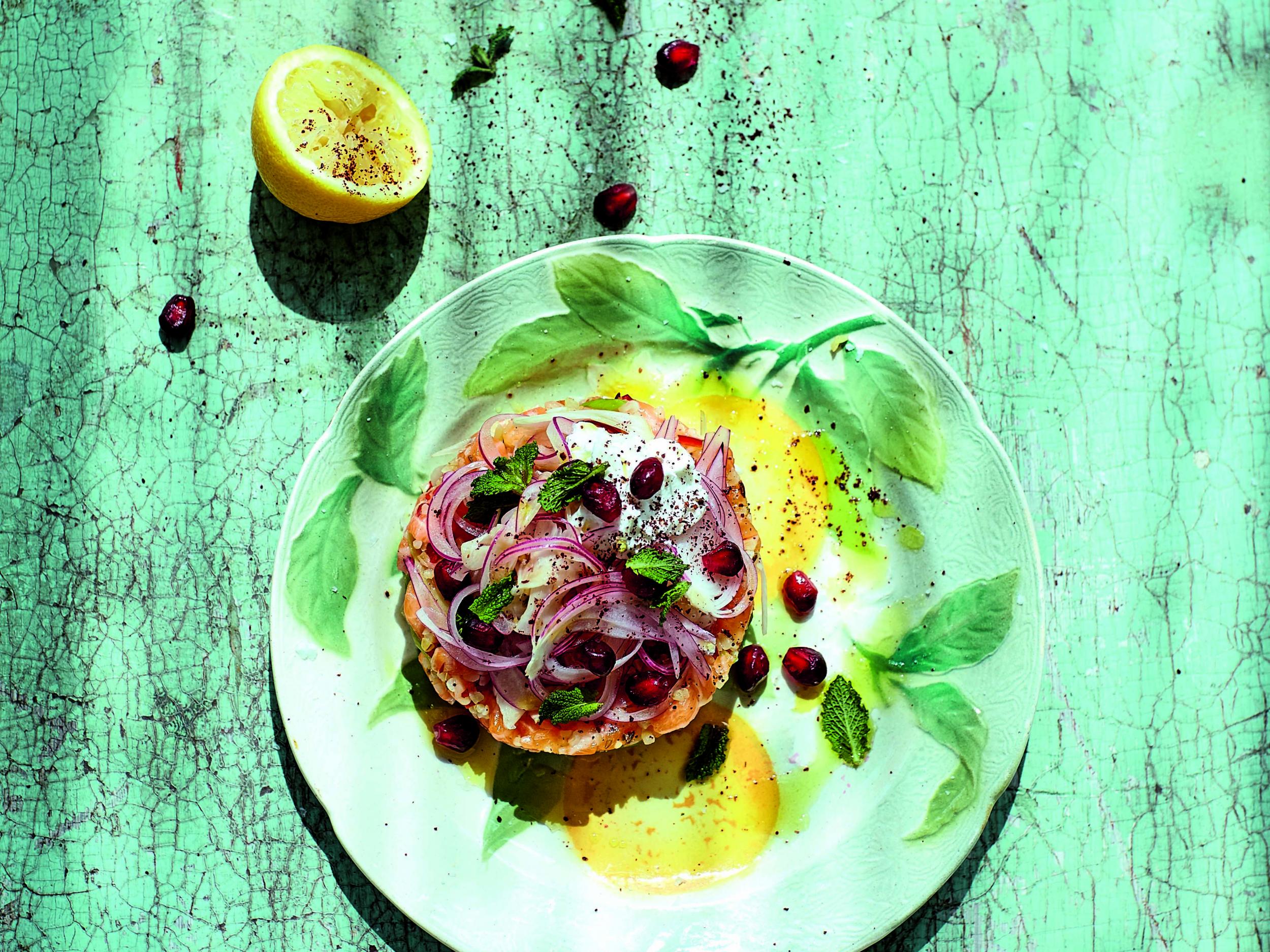‘Jikoni’ cookbook: Recipes from cauliflower popcorn to salmon tartare
Ravinder Bhogal’s second book is based on the food from her restaurant of the same name that reflects her British, Indian and African heritage

Your support helps us to tell the story
From reproductive rights to climate change to Big Tech, The Independent is on the ground when the story is developing. Whether it's investigating the financials of Elon Musk's pro-Trump PAC or producing our latest documentary, 'The A Word', which shines a light on the American women fighting for reproductive rights, we know how important it is to parse out the facts from the messaging.
At such a critical moment in US history, we need reporters on the ground. Your donation allows us to keep sending journalists to speak to both sides of the story.
The Independent is trusted by Americans across the entire political spectrum. And unlike many other quality news outlets, we choose not to lock Americans out of our reporting and analysis with paywalls. We believe quality journalism should be available to everyone, paid for by those who can afford it.
Your support makes all the difference.Cauliflower popcorn with black vinegar dipping sauce
Serves 4 as a starter
1 cauliflower, cut into small florets
Small handful of Thai basil leaves
6 spring onions, thinly sliced
2 red chillies, thinly sliced
4 garlic cloves, thinly sliced
Groundnut oil, for deep-frying
Lime wedges, to serve
For the dipping sauce
100ml Chinkiang black vinegar
80ml light soy sauce
1 red chilli, finely chopped
Small thumb of ginger, finely grated
2 tsp toasted sesame oil
1 tsp caster sugar
1 tbsp sesame seeds, toasted
For the batter
2 tsp Sichuan peppercorns
2 tsp black peppercorns
2 tsp sea salt
200g plain flour
4 tbsp cornflour
About 300ml ice-cold sparkling water
Deep-frying is like the icing sugar of cookery – it just makes everything taste so much better! This crisp, battered manifestation of the humble cauli is based on one of the dishes I can never resist when I go to a Chinese restaurant: salt and pepper squid. The batter is laced with mouth-tingling Sichuan peppercorns, which are dry-roasted to tease out their fragrance and flavour, along with some more assertive black peppercorns for a bit of heat. Importantly, the popcorn should really be scarfed as soon as it hits the plate.
To make the dipping sauce, simply whisk together all the ingredients. For the batter, heat a dry frying pan over medium heat and toast the peppercorns until they are aromatic. Tip into a pestle and mortar, along with the salt, and crush to a coarse powder. Empty out into a mixing bowl, add both flours and mix well. Now whisk in the sparkling water, adding just enough to make a batter with a double-cream consistency, and being careful not to overbeat.
Fill a large, heavy-based saucepan a third full with the deep-frying oil. Heat the oil to 180C – if you don’t have a thermometer, you will know the oil is ready when a cube of bread turns golden brown in 20 seconds. Dip the pieces of cauliflower into the batter, one at a time, letting the excess drip off, and deep-fry until golden. Remove with a slotted spoon and drain on kitchen paper. Dip the basil leaves in batter and fry in the same way. When you have finished frying the cauliflower and basil leaves, carefully pour out most of the oil from the pan, leaving just a few tablespoons. Place over medium-high heat and flash-fry the spring onions, chillies and garlic for a minute or so, until the garlic is just beginning to colour. Drain on kitchen paper, scatter over the cauliflower and toss. Serve immediately, with lime wedges for squeezing and the dipping sauce alongside.

Levantine salmon tartare with pickled fennel and labneh
Serves 6 as a starter
Sea salt and black pepper
Extra virgin olive oil, for drizzling
Sumac, small mint leaves and pomegranate seeds, to garnish
For the labneh
125g yoghurt
1 small garlic clove, finely chopped
Generous pinch of salt
For the pickled fennel
250ml cider vinegar
50g caster sugar
1 tsp fennel seeds
1 tsp yellow mustard seeds
5 black peppercorns
1 fennel bulb, finely shaved
1 small red onion, very thinly sliced
For the tartare
500g very fresh salmon fillet, skinned and pin-boned
50g bulgur wheat, soaked in hot water for 5 minutes
4 spring onions, thinly sliced
1 tsp ground allspice
1 tsp cumin seeds, toasted and lightly crushed
1 small red chilli, deseeded and finely chopped
2 tbsp extra virgin olive oil
In the power-dressing 1980s, tartare was pretty much a mound of raw, chopped-up beef bound together with mustard, capers and chives, topped with a raw egg yolk. It was the preserve of the showy Wall Street set who liked status symbols and stuffy restaurants. Thankfully, over the years, tartare has been reinterpreted in different ways, with ingredients as varied as tuna and tomatoes. This spiced version is inspired by the Levant, where it is normally made with raw lamb. I’ve used delicate salmon for a bright, refreshing dish, pairing it with a brazenly acidic pickled fennel and luscious labneh, rather than the traditional egg yolk. You’ll need to make the labneh in advance – but if you’re short of time, you could just use 4 tbsps of thick yoghurt or ready-made labneh instead.
For the labneh, mix together the yoghurt, garlic and salt. Line a bowl with a large square of muslin and spoon in the yoghurt. Gather the corners of the muslin and knot together, then tie to a rack in your refrigerator, placing the bowl underneath to catch any drips. Leave to drain overnight. For the pickled fennel, combine the vinegar and sugar in a small non-reactive saucepan and stir over low heat until the sugar dissolves. Stir through the spices, then leave to cool. Add the fennel and onion, pour into a glass bowl or jar and refrigerate for 2 hours or overnight.
Make the tartare on the day you want to serve it. Use a large sharp knife to finely chop the fish – it may be worth putting it in the freezer for half an hour beforehand to make this easier. In a bowl, combine the salmon with the well-drained bulgur wheat and the remaining ingredients and season to taste with salt and pepper, then cover and refrigerate until chilled. Divide the salmon tartare into 6 equal portions. Place a pastry ring on a serving plate and spoon a portion of tartare into it, then remove the ring. Repeat with the rest of the tartare. Top with the pickled fennel and a spoonful of labneh, then drizzle with olive oil. Finish with a scattering of sumac, mint leaves and pomegranate seeds. Serve at once.

Lamb and aubergine fatteh
Serves 6
4 tbsp olive oil
4 lamb shanks
1 cinnamon stick, broken up
2 tsp allspice berries
2 tsp coriander seeds
6 green cardamom pods, bruised
1 tsp black peppercorns
2 red onions, unpeeled, cut into quarters
1 whole garlic bulb, halved crossways
2 aubergines, thinly sliced into rounds
1 × 400g tin chickpeas, drained
2 Lebanese flatbreads
Groundnut oil, for deep-frying
1 tbsp ghee
2 tbsp flaked almonds
2 tbsp pine nuts
Seeds from 1⁄2 large pomegranate
1 tbsp black sesame seeds
1 tsp sumac
Handful of parsley leaves
Sea salt and black pepper
For the sauce
250g yoghurt
1 tbsp tahini
Juice of 1 lemon
1 garlic clove, crushed
For the salsa
1 heaped tsp Turkish pepper paste (biber salcasi) or good-quality harissa
2 tbsp olive oil
Juice of 1 lemon
4 tomatoes, peeled and finely chopped
1 red onion, finely chopped
1 green pepper, finely chopped
Large handful of finely chopped parsley
1 tsp sumac
1 tsp Turkish pepper flakes (pul biber)
1⁄2 tsp dried mint
Fatteh is a layered feasting dish. This one features lamb, aubergine and pulses, ladlefuls of garlic-spiked tahini yoghurt sauce and spicy tomato salsa, all topped off with fried shards of flatbread, pine nuts and almonds – and that most iconic Middle Eastern ingredient, pomegranate. This is a great recipe for a crowd. With every bite, your guests will luxuriate in different flavours.
Preheat the oven to 180C/160C. Pour 2 tbsps of the oil into a large flameproof casserole over high heat and sear the lamb shanks all over. Add the cinnamon, allspice, coriander seeds, cardamom pods, peppercorns, onions and garlic and fry for 1 minute. Pour in 1.5l of water, then cover and cook in the oven for 2 hours.
In the meantime, place the sliced aubergine on a lined baking sheet, drizzle over the remaining 2 tbsps of oil and season with salt and pepper. Roast in the oven for 45 minutes or until soft, then set aside. Make the sauce by simply mixing all the ingredients together.
For the salsa, put the paste, oil and lemon juice into a bowl, season with salt and pepper and stir until well combined, then add the tomatoes, red onion, green pepper, parsley, sumac, Turkish pepper flakes and dried mint. Take the lamb out of the oven and add the chickpeas, then cover again and return to the oven for a further 30 minutes.
Using scissors, cut the Lebanese bread into bite-sized shards. Fill a large, heavy-based saucepan a third full with the deep-frying oil. Heat the oil to 180C – if you don’t have a thermometer, you will know the oil is ready when a cube of bread turns golden brown in 20 seconds. Fry the flatbread for 1 minute, or until golden and crisp, then drain on kitchen paper.
Heat the ghee in a frying pan over medium heat and fry the almonds and pine nuts until golden and toasty, keeping a close eye on them as they can quickly burn. Drain on kitchen paper.
To serve, lift the lamb shanks out of the casserole and onto a chopping board. Shred the meat with two forks, then lay over a serving dish. Fish out the chickpeas with a slotted spoon and tumble over the lamb, along with a few ladlefuls of the stock to moisten the lamb. (Keep the rest of the stock to make soup another time.) Cover the lamb and chickpeas with the aubergines, arranging them in a single layer, followed by the tomato salsa and dollops of the yoghurt sauce. Finish with the fried flatbread, almonds, pine nuts, pomegranate seeds, sesame seeds, sumac and parsley.
‘Jikoni: Proudly Inauthentic Recipes’ from an Immigrant Kitchen’ by Ravinder Bhogal (£26, Bloomsbury). Photography © Kristin Perers
Join our commenting forum
Join thought-provoking conversations, follow other Independent readers and see their replies
Comments